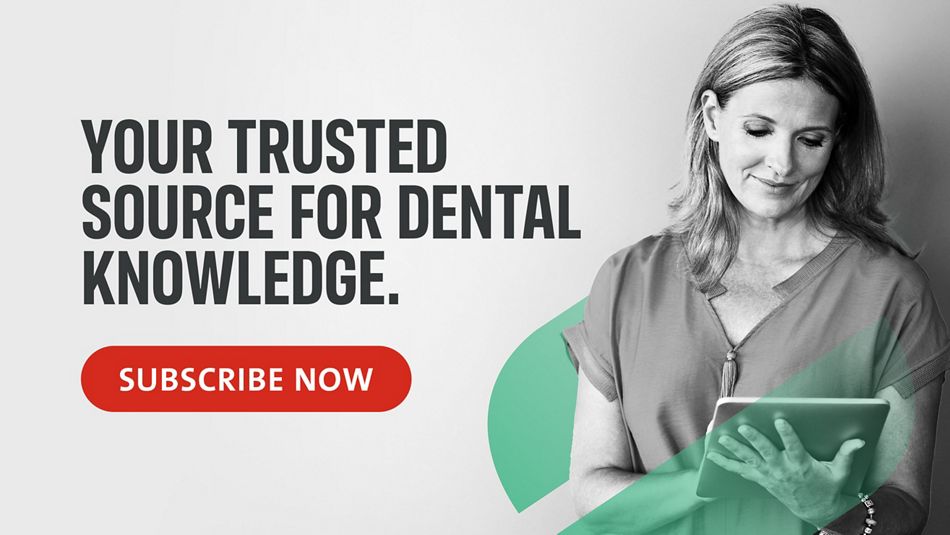With treatments covering ever broader indication ranges and implant therapy becoming a standard in dental treatments, the community is also experiencing a related increase in the incidence and prevalence of complications, including biological complications and peri-implant disease1–5. Research to better understand the causality and etiology and to provide adequate treatment options has intensified in recent years to address this tackling problem.
The World Workshop on Periodontology in 2017 in Chicago, USA, represented a major milestone for addressing peri-implant disease more systematically. For the first time, international experts elaborated a consensual classification for the different categories and stages of peri-implant disease based on defined clinical diagnostic criteria6,7. Specifically, three peri-implant clinical conditions were defined, rendering peri-implant disease classification and associated treatments more homogeneous and systematic:
- Peri-implant health8 refers to a state that is defined by the absence of clinical signs of mucosal inflammation, like erythema, bleeding on probing, swelling or suppuration. It is important to note that peri-implant health may result irrespective of potentially advanced probing depths or reduced bone support, for example after the successful resolution of peri-implant disease.
- Peri-implant mucositis9 refers to an inflammatory condition of the peri-implant soft tissues without affecting marginal bone. The main clinical manifestation of peri-implant mucositis is a combination of bleeding on gentle probing, erythema, swelling and/or suppuration. Scientific evidence suggests that bacterial plaque is the primary etiological factor contributing to the development of peri-implant mucositis10. Causative therapy comprising, for example, plaque removal and control are vital in addressing the condition and may alleviate or fully resolve it.
- Peri-implantitis11 is an inflammatory condition affecting the peri-implant mucosa and bone, and is typically associated with gradual and irreversible resorption of the latter. It usually presents with bleeding and/or suppuration on gentle probing, increased probing depths (≥6mm) and/or recession of the peri-implant mucosal margin. Compared to peri-implant mucositis, the diagnosis of peri-implantitis is defined by a radiographic bone loss of ≥3mm6. Peri-implantitis may develop from peri-implant mucositis if left undiagnosed or untreated. Compared to periodontitis, peri-implantitis usually manifests by a faster and progressively accelerating pattern, underlining the importance of engaging patients in strict periodic maintenance regimens to detect and treat any pathological peri-implant condition as early as possible (Figure 1).
Prevalence
The literature-reported prevalence of peri-implantitis varies considerably. Reported values range from as low as 1 % to as high as 47 %1. Based on a systematic review, Derks & Tomasi2 recently reported a consolidated value of 22 %. This value aligns well with the value of 24 % that has recently been reported as a representative value for the Spanish patient population5. The large variations in reported prevalence rates may at least partly be related to the variance in disease definitions and classification criteria applied across different studies, which may have shifted prevalence rates depending on factors such as the degree of bone loss. As the latter characteristic increases with ongoing disease progression, it may be assumed that the reported prevalence values may, among other factors, have also been influenced by the different follow-up periods of the individual studies4,12.
Peri-implantitis defect morphology
Peri-implant osseous defect morphology resulting from peri-implantitis represents a critical factor in peri-implantitis therapy. Specifically, this factor can be used to determine the severity of the disease, but it also influences the effectiveness of cleaning modalities and the prognosis of, for example, regenerative therapy. These arguments render peri-implant defect morphology crucial for the decision-making in peri-implantitis therapy13–15.
The most widely accepted peri-implant defect morphology classifications were developed by Schwarz et al. and extended by Monje et al. and are based on clinical defect-anatomical and radiographic preclinical and clinical studies13,14,16. Based on these classifications, peri-implant defects can be categorized mainly into three types of morphologies, i.e. those with a purely infraosseous component (Class I) (Figures 2B & D), suprabony or supracrestal defects (Class II) (Figure 2A), or combined defects displaying both an infraosseous and a supracrestal component (Class III) (Figure 2C). Furthermore, the lateral extension of the infraosseous component is used to subdivide the defects further into "a-type defects" with buccal dehiscence, "b-type defects" characterized by the loss of two or three bony walls, and c-type circumferential contained defects17. Finally, defect severity based on the vertical progression of bone resorption extends and completes the classification. Specifically, the latter is based on the defect depth extension below the implant neck or the ratio of bone loss related to the total length of the implant and classifies the different defects into 3-4 mm small (S), 4-5 mm medium (M) to >6 mm advanced (A) defect types.
Defect classification is proving increasingly useful to guide treatment decisions. Small supracrestal Class II defects, for example, may typically respond well to nonsurgical and/or flapless treatments, as well as approaches involving an access flap or resective techniques. Conversely, intraosseous Type I defects with a purely contained circumferential morphology (Class Ic) have been shown to respond much better to guided bone regenerative treatments compared to those with a buccal dehiscence component (Class Ib)15.
Peri-implantitis treatment options
Implant surface decontamination
The central goal of peri-implantitis therapy is to prevent disease progression or recurrence and, potentially and preferentially, reconstruct lost tissues and reestablish osseointegration18. Next to the review of present or changed behavioral, functional or systemic risk factor profiles and their potential correction, implant surface decontamination from plaque and bacterial biofilm to control and halt the tissue inflammatory processes represents a central element of the therapeutic approaches in peri-implantitis therapy19,20.
Various implant surface decontamination techniques have been presented. Depending on whether their mode of action is primarily based on physical, mechanical or chemical principles, these techniques may be classified into four groups21–23. Adequate access to the implant surfaces is crucial for most of these techniques to work effectively. Combinatorial approaches are often used as therapeutic strategies by combining, for example, mechanical sonic/ultrasonic instrumentation and chemotherapeutic irrigation, e.g. chlorhexidine21,24. Mechanical debridement is generally considered among the scientifically best-documented methods in effectively removing implant-associated biofilms25,26. These methods include ultrasonic instrumentation with specific tips that can be used on the metallic implant surfaces27, rotating brushes28 and air abrasive devices using, e.g. glycine and/or erythritol particles29 (Figure 3).
Louropoulou and co-workers have raised another important aspect related to implant surface debridement: ideal methods are required not only to effectively remove bacterial plaque and calculus from the implant surface, but also to ensure the integrity of the latter30,31. With this regard, a recently presented electrolytic implant cleaning technique appears as an attractive and novel approach that may fulfil both these requirements32,33.
Nonsurgical therapy
Nonsurgical causative therapy is of pivotal importance as the first line of intervention, irrespective of the progression and severity of peri-implant disease20,34. Several studies have demonstrated the effectiveness of causative therapy in controlling inflammation and halting the progression of the disease. Typical approaches involve the use of different decontamination methods and treatment protocols, with or without co-adjuvant antibiotic therapies20,35. In addition to these positive reports, future advances in decontamination methods may help further improve the effectiveness and success rates of nonsurgical therapy36.
Despite these promising results and its ability to reduce clinical signs of peri-implant inflammation, nonsurgical therapy alone is currently considered insufficient to achieve complete disease resolution. Also, nonsurgical therapy has been shown to be ineffective in influencing the success of subsequent surgical interventions37. Therefore, surgical peri-implant follow-up therapy is often necessary, whether resective, reconstructive or combined34,37,38.
Surgical therapy
The ultimate goal of surgical therapy is to reconstruct the osseous defect to support the peri-implant soft tissues18. Compared to other modalities, like access flap and resective approaches, reconstructive approaches have proven clear advantages regarding esthetic outcomes39. However, their application may be limited by the defect morphology, severity, and stage of disease progression, rendering the prognosis of reconstructive approaches poor when compared to alternative, e.g. resective, treatment17. Implantoplasty may be used to smooth exposed endosteal surface parts and to remove or reduce the threads on the implant surface as part of the latter approaches to reduce the risk of plaque formation and infection25. The removal of granulation tissue and adequate surface decontamination represent hallmarks of any regenerative surgical therapeutic approach17,18,26. These steps are also essential to entirely reveal and fully evaluate the peri-implant defect configuration to plan the therapeutic approach (see clinical case illustration in Figures 4, 5 and 6).
Regenerative treatment is generally more predictable for contained circumferential defects, while its prognosis has been reported to decrease for buccal dehiscence defects with increasing extension15,17. General guidance on whether a regenerative, augmentative, or resective approach should be chosen can, for example, be obtained based on the number of residual bony walls and suprabony components. As a general rule, reconstructive approaches become less predictable in defects, the fewer bony walls remain, and the more suprabony components have been lost. Conversely, resective approaches may be recommended in such instances17.
The use of biomaterials in regenerative surgical peri-implantitis theraphy
The use of biomaterials to reconstruct the intra-osseous component of peri-implant defects to improve soft tissue support and aesthetics has recently attracted much interest18,40. Despite recent progress in the field, individual studies remain tempered by high levels of heterogeneity between individual study setups, rendering the comparison of different approaches difficult40. While a general consensus on the overall effectiveness of regenerative treatment could still not be achieved, recent systematic reviews indicate some clinical benefits of regenerative surgical peri-implant therapy41,42 (see case illustrations 2, 3 and 4 in Figures 7 to 15).
- The use of bone grafts in reconstructive peri-Implant therapy
Numerous studies have addressed the use of bone grafts for the reconstruction of peri-implant defects. Promising results were, e.g. reported by, for example, Derks et al., who showed that reconstructive surgery might lead to favourable results in soft tissue support, i.e. buccal recession, when compared to resective approaches43. Despite these promising results, individual studies show considerable heterogeneity in study design, clinical setups and procedural and indication-related aspects, includingcomprising, e.g., implant and fixture systems, surface decontamination methodology and follow-up time points. This heterogeneity has limited any comparison of the effectiveness of used materials and to concludeany conclusion on the effectiveness of delivered treatments so far 40–42,44.
A recent systematic review has reported some benefits of using bone grafts compared to access surgery and decontamination of the implant surface alone regarding radiographic bone fill. Despite these promising outcomes, randomized clinical trials with adequate sample sizes and long-term follow-up times are required to support a potentially more robust conclusion41,44.
→ Autologous bone grafts
Based on their unique combination of osteogenic, osteoconductive, and osteoinductive properties, autologous grafts are often regarded as the gold standard for bone augmentation45. As a result, different research groups have focused on using this type of bone graft for the reconstructive approach in peri-implantitis. While some studies have shown promising results, others have indicated efficacy in selected subcohorts with reduced peri-implant defect sizes46,47. A direct comparative study has recently indicated the inferior performance of autologous bone grafts compared to xenografts after a follow-up time of 12 months. This result may support the general notion that a clear recommendation for using autologous bone grafts for treating peri-implantitis defects remains pending48.
→ Allogeneic bone grafts
Allogeneic bone grafts contain most of the essential osteogenic factors of autologous bone, i.e., the collagenous matrix and proteins, while deprived of viable osteogenic cells45. Nevertheless, depending on their type, allografts show biological properties which are, in part, comparable to those ones of autologous bone, such as osteo-induction and conduction45. Potential disadvantages of allografts may be associated with slower regeneration, requiring potentially prolonged follow-up times, and the fact that their use may result in potentially smaller newly formed bone volumes compared to autologous grafts50,51 Despite these limitations, these overall beneficial properties, in combinedation with the advantage of not requiring a second surgical donor site, have fostered an increasing use of allografts in periodontics and implant dentistry in recent years49.
Nart et al. have recently reported promising 12-month follow-up results after using an allograft combined with local antibiotics to reconstruct peri-implant bone defects (Nart et al. 2017). Additionally, a recent randomized clinical trial has assessed the use of an additional membrane in conjunction with allografts compared to allografts alone52. As part of this laetter study, both treatment modalities, i.e., the one with and without membrane, showed comparably successful outcomes and thus failed to show an additional benefit of the applied membrane.
→ Xenogeneic bone grafts
The use of xenografts in implant dentistry is well-established and backed up by many scientific publications. By contrast to autologous bone and some types of allogeneic materials, this type of graft does not display osteoinductive properties, restricting its capacity to promote bone formation to its osteoconductive properties. The use of xenogeneic graft materials in the form of a xenograft collagen composite was recently demonstrated as part of a multi-centere randomized clinical trial43. Specifically, this trial evidenced that, compared to access flap surgery alone, the additional use of a bone graft was more favourable in preventing apical migration of the peri-implant soft tissues, whilst showing equivalent outcomes in other clinical parameters.
- The use of barrier membranes in reconstructive peri-Implant therapy
The use of barrier membranes in simultaneous augmentation procedures to prevent soft tissue ingrowth and promote bone formation as part of implant placement in pristine bone is well-documented and generally recognizsed (Sanz-Sanchez et al. 2015). In contrast to de novo implant placement, usingthe use of barrier membranes as part of reconstructive peri-implant therapy remains controversial and potentially limited by postoperative complications, decreasing the performance of this treatment modality.
Roos-Jansåker et al. performed several clinical trials to study the effectiveness of barrier membranes in reconstructive surgery by comparing bone grafts with or without the additional use of resorbable barrier membranes. The authors of these investigations reported similar and comparable outcomes of both modalities over follow-up periods of up to 5 years, without identifying a clear advantage of barrier membranes in terms of clinical outcomes54–57. Additionally, our group and Monje et al. have recently performed two randomized clinical trials using xenogeneic or allogeneic bone grafts with the same outcome52,58. The former study further revealed that the use ofusing barrier membranes in reconstructive surgery may be associated with higher postsurgical complication rates, i.e. membrane exposures and increased postoperative pain, compared to procedures using bone graft only58.
- The use of biologics in reconstructive peri-Implant therapy
→ Enamel matrix derivative (EMD)
Enamel matrix derivative and the corresponding commercial formulation Emdogain® can be regarded as being among the best-studied and most widely used biologic agents in dentistry59. Numerous preclinical and clinical studies have histologically and clinically demonstrated its ability to successfully promote periodontal wound healing and regeneration when used as part of periodontal surgery59,60. A meta-analysis concluded that EMD application as part of open flap surgery resulted in an average additional 1.30 mm of clinical attachment level gain 61. EMD has been proven to possess a series of beneficial biological properties, including antibacterial, anti-inflammatory, angiogenic and osteopromotive properties, rendering it potentially attractive for use in peri-implant therapy..
Using EMD as an adjunct to nonsurgical and surgical regenerative peri-implant therapy has recently attracted considerable interest. It has been studied as part of case series and randomized controlled clinical trials. Esberg et al., for example, have, e.g. reported that the use of EMD in nonsurgical therapy was associated with implant survival after 12 months, and Kashefimehr et al. have shown that EMD application after mechanical implant surface debridement resulted in improved clinical outcomes and a reduction of inflammatory markers when compared to corresponding procedures without EMD71,72.
Isehed et al. evaluated the use ofusing EMD for the reconstructive therapy of peri-implantitis defects in a pilot study setting. They reported that its useusing EMD led to an increased marginal bone level after 12 months and increased implant survival compared to the control group that did not receive EMD 73,74. A further pilot study by Mercado et al. documented the use of xenograft/cCollagen in combination with the local application of EMD and dDoxycycline. This treatment modality resulted in a 56.6% treatment success rate based on probing depth reduction, resolution of inflammation and minimial recession after a follow-up of 36 months75. Despite these promising results, the evidence on the use ofusing EMD for reconstructive peri-implant surgery requires further substantiation by larger randomized clinical trials before allowing to draw any general conclusion can be drawn on its effectiveness.
→ Platelet-derived growth factors (PDGF) and Platelet-rich fibrin (PRF)
Other adjunctive biologics proposed to promote regeneration and soft tissue healing in peri-implant surgical procedures are platelet-derived growth factor (PDGF) and Pplatelet-rich fibrin 76. The use of PDGF iIn peri-implant therapy, for example, PDGF has, e.g. been shownused in combination with EMD for the reconstruction of peri-implant intra-osseous defects77. Other pilot studies report favourable results using platelet-rich fibrin (PRF) compared to the simple intervention comprising access flap and decontamination of the implant surface alone78. Future studies of these agents in combination with bone graft substitutes may help to further evaluate the clinical efficacy and cost-benefit of these adjuncts in reconstructive peri-implant therapy.
Conclusion
Securing and maintaining peri-implant health requires a deep understanding of the clinical and epidemiological aspects of peri-implantitis. Strict and personalized recall regimens with accurate clinical diagnosistic and a regular assessment for changing risk factor profiles remain essential for an early diagnosis of peri-implant disease.
A multifaceted approach, combining surgical and nonsurgical treatments alongside supportive and causative therapy, has shownproved to be most effective in managing peri-implantitis. Treatment modalities should always be tailored to the actual patient's clinical picture. Healthcare professionals need to stay updated with ongoing research and evolving clinical guidelines to provide the best possible care for their patients. Continued advancements in our understanding of the disease, alongside updated research, clinical guidelines and standardized treatment modalities, are necessary to enhance clinical and patient-centered outcomes in the future.


